扩展功能
文章信息
- 徐永强, 何永宏, 仲向云, 马静, 陈霖, 焦军, 朱玉双
- XU YongQiang, HE YongHong, ZHONG XiangYun, MA Jing, CHEN Lin, JIAO Jun, ZHU YuShuang
- 特低渗岩性油藏间连通性表征研究——以鄂尔多斯盆地马岭地区长8油藏为例
- Research on the Connectivity Characterization among the Ultra-low Permeability Lithologic Reservoirs: Case study of the Chang 8 reservoir in the Maling area of the Ordos Basin
- 沉积学报, 2019, 37(3): 623-632
- ACTA SEDIMENTOLOGICA SINCA, 2019, 37(3): 623-632
- 10.14027/j.issn.1000-0550.2018.150
-
文章历史
- 收稿日期:2018-05-10
- 收修改稿日期: 2018-06-29
2. 中国石油长庆油田分公司开发事业部, 西安 710018;
3. 中国石油长庆油田分公司勘探开发研究院, 西安 710018
2. Development Department, Changqing Oilfield Company, PetroChina, Xi'an 710018, China;
3. Research Institute of Exploration and Development, Changqing Oilfield Company, PetroChina, Xi'an 710018, China
在成藏规律一致、相互连通的油藏之间,且具有成藏条件的区域,寻找新的油气富集区可以大大降低勘探风险,因此,通过分析油藏间连通性可为有利区预测及进一步勘探部署提供依据。过去人们对储层砂体静态连通性研究较多,而对油藏的连通性研究较少[1-2]。目前国内外有关连通性的研究多是用于范围较小或单一油藏内的井间连通性[3-4],主要为了解决开发问题,而对于较大范围内、距离较远的油藏之间的连通性研究较少,这制约了较为隐蔽的岩性油藏的勘探,因此研究岩性油藏间的连通性具有实际意义。
储层砂体的连通性是油藏连通性的基础,是在不考虑断裂作用的情况下,分析各套砂体之间的接触关系[5]。砂体连通的必要条件是各套砂体之间能够相互切割叠置、接触,为此国内外学者已开展了大量的研究工作,取得了较多的成果和认识。田景春等[6]以鄂尔多斯盆地高桥地区二叠系山西组及盒8段为例将其储集砂体叠置样式分为冲刷切割型、冲刷接触型和连续过渡接触型。封从军等[7]在沉积时间单元划分和密井网资料统计的基础上总结了复合分流河道砂体的六种叠置关系,包括:多层式、叠加式、多边式、单边式、对接式、孤立式,且随着砂体间叠置关系由多层式向孤立式发展其砂体间的连通性逐渐变差。赵春明等[8]在分析辫状河沉积砂体连通模式时指出,由于辫状河道快速频繁的摆动使多个成因的砂体在垂向及侧向上相互对接,形成了广泛连通的厚砂体。Leeder[9]总结出根据砂坝厚度计算水深的经验公式,进而预测河道宽度。Bridge et al.[10-11]提出辫状河河道带宽度与其平均满槽深度有一定统计关系,进而可计算河道带宽度。Allen[12]提出了砂地比的临界值来预测河道砂体的连通程度,裘怿楠[13]根据我国湖盆的发育特征,对Allen的临界值做出了补充修改,King[14]利用逾渗理论分析了叠置砂岩体间的连通性,罗晓容等[5],雷裕红等[15],Lei et al.[16],赵健等[17]借鉴储层描述的思路和方法,提出利用砂地比来计算砂岩连通概率的公式。上述国内外研究学者是通过研究砂体的叠置样式、发育规模来分析各套砂体在纵横向上能否接触,最终判断砂体的静态连通性。而利用动态资料研究连通性的方法很多,常用的分析方法有试井分析法(包括脉冲试井[18]、不稳定试井[19]等)、井间化学示踪剂测试[20-22]、井间动态数据反演方法[23-31]、电容模型[32-41]等。这些方法主要是利用各种监测技术或生产数据来分析井间流体连通性,但在油田开发早期、中期,动态资料较少的情况下,则可利用地层压力分析[42]或地球化学方法(主要包括地层水分析[43]、原油组分分析[42]、原油色谱指纹技术[44-47])来判别油藏流体的连通性。其中,原油色谱指纹技术是判断油藏连通性的常用方法,且在鄂尔多斯盆地油藏连通性的研究取得了较好的应用效果[48-51]。
本研究以鄂尔多斯盆地马岭地区长8段特低渗岩性油藏为例,并以储层砂体静态连通性研究为基础,以油藏动态分析方法为理念,建立了基于夹层的发育状况下砂体连通概率公式,利用原油全烃色谱资料分析各油藏之间的连通性,为下一步勘探部署提供依据。
1 研究区概况研究区位于鄂尔多斯盆地西南部,区内构造相对简单,地层平缓,盆地内无二级构造,三级构造仅发育一系列幅度较小的鼻状隆起。研究区长8段沉积相类型以辫状河三角洲前缘亚相为主,物源来自南西方向,向北东方向延伸。长8期分流河道不断发生改道与迁移,且频繁交织与汇合,使得长8小层砂体变化大,储层非均质性强。马岭地区长8段的河道砂体规模较大,其物性要好于周围泥质岩类、致密砂岩,为油藏中的“甜点”,是油气富集区带[52]。根据马岭地区长8油藏的开发状况,可将各个已滚动建产开发区块分别作为一个小油藏,分为①~⑩油藏(图 1)。

|
| 图 1 鄂尔多斯盆地马岭地区长8段砂体厚度分布及油藏分布图 Figure 1 Distribution of sand body thickness and various small oil reservoirs in the Chang 8 member in Maling area of Ordos Basin |
储层砂体连通是油藏连通的基础,储层砂体间静态连通性是指各套砂体在垂向上和侧向上相互接触连通的方式及程度,在缺乏地震资料的情况下,需在分析砂体发育规模的基础上判断各套砂体间能否接触连通。
2.1 砂体发育规模分析储层砂体纵向叠置关系及横向发育规模直接影响着储层砂体的静态连通性。
2.1.1 砂体纵向叠置样式根据野外露头观察及密井网砂体精细解剖,可将研究区长8段辫状河三角洲前缘河道砂体叠置样式分为三种,即孤立式、接触式、切叠式。其中孤立式在剖面上表现为各套砂体间分散呈孤立状,彼此不连通;接触式表现为纵向多期道砂体的垂向接触,但往往由于前期河道上部旋回的细粒沉积保存较为完整,使相邻两期河道沉积砂体连通性差甚至不连通;切叠式是由于河道左右频繁迁移并时常切割下伏河道砂体而形成,该样式砂体几何连通性较好(图 2)。
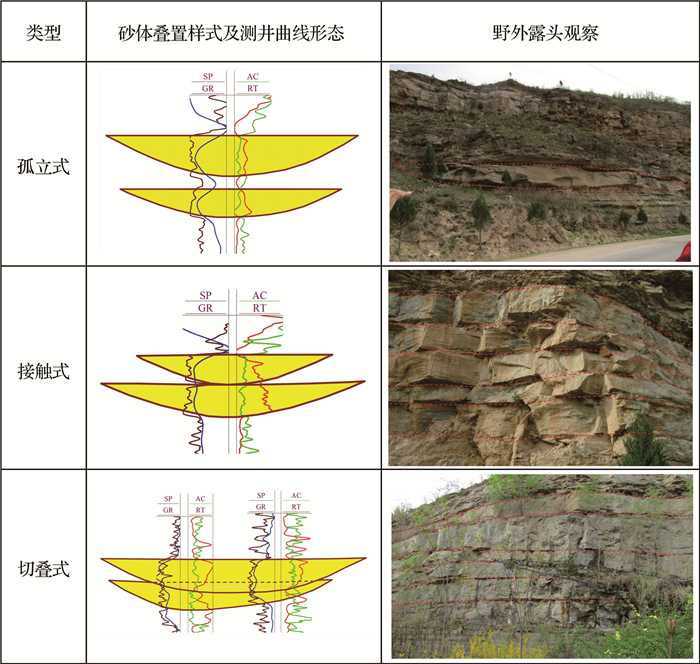
|
| 图 2 鄂尔多斯盆地马岭地区长8段砂体叠置样式 Figure 2 Superposition models of sand body in the Chang 8 member in the Maling area of the Ordos Basin |
前人通过野外露头观察和现代沉积测量发现,单一水下分流河道砂体的宽度和深度存在良好的相关性[53]。可根据野外露头、现代沉积及研究区密井网资料,建立单一河道砂体宽度与厚度之间的定量模式,预测单一河道的规模,进而指导稀疏井区单砂体的刻画工作[54]。
由于辫状河河道快速频繁的摆动使多个成因的砂体在垂向及侧向上相互对接,形成广泛分布的切叠式厚砂层,故常被称为“泛连通体”或辫状河河道带。根据前人对河道及河道带宽度预测分析可得出如下计算公式[9-11, 55]:
 (1)
(1)
式中,h为水深,m;L为河道砂坝的厚度,m;w为河道宽度,m。
 (2)
(2)
式中,Chw为辫状河河道带宽度,m;dm为平均满岸水流深度,m,可用河道砂坝砂体厚度代替。
在前人研究基础上,对辫状河三角洲前缘河道砂体的野外露头观察和测量以及测井资料分析统计,研究区长8段水下分流河道砂体厚度分布在1~12.5 m之间,平均2.9 m;河道宽度分布在12.7~620.8 m之间,平均65.7 m;河道带宽度分布在124~11 717 m之间,平均850 m(图 3)。

|
| 图 3 研究区河道砂体厚度及河道带宽度分布 Figure 3 Thickness distribution of channel sand body and river channel belt width in the study area |
为了量化分析研究区砂体的连通性特征,选择井网密集、各类资料丰富的镇339井区作为解剖对象,该区也属于鄂尔多斯盆地南西沉积体系,沉积微相类型与马岭地区一致。根据该区域的地质资料及砂体发育规模分析,绘制垂直物源方向的砂体连通剖面图(图 4)。可看出砂体较为发育的层段,其砂体叠置样式以切叠式为主,连通性较好;而孤立型砂体之间相互独立,连通性差。
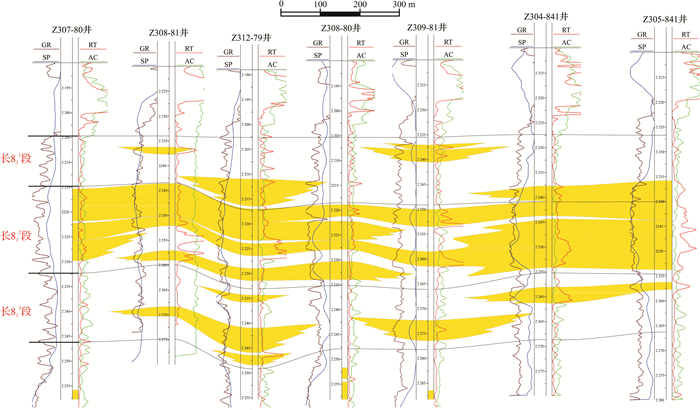
|
| 图 4 密井网砂体连通剖面图 Figure 4 Connected section of the sand body from the dense well pattern area |
在表征砂体发育规模的各个参数中,砂体厚度是最为重要的参数,但信息较为单一,而对于研究区地层厚度变化不大的特征,砂地比不仅一方面反映砂体厚度信息,进而预测砂体宽度,也能反映研究区沉积相带变化,因此本次研究中可将砂地比来反映砂体发育规模并与连通性进行分析。
罗晓容等[5]、雷裕红等[15]、Lei et al.[16]、赵健等[17]根据砂地比来计算砂体连通概率取得了较好的应用效果,其计算公式为:
 (3)
(3)
式中,P为砂体连通概率;Sn为砂地比;b=(C-C0)/ 
研究中通过对密井网区域解剖,统计分析了砂体连通概率与砂地比的相关关系(共128个统计数据)。具体方法是先记录每一口井每一层段的砂地比值,并通过剖面图分析该层段砂体能否与左右两口井中相应层段的砂体连通,再将砂地比值从0到1平均划分为20个区间,统计各个区间中对应的砂体连通的样本在总样本中所占的百分比,获得砂体连通概率与砂地比间的相关关系。可看出砂地比与砂体连通概率整体呈正相关关系,即砂地比值越大则砂体连通性越好。但将统计结果与式(3)计算结果对比可见二者差异较大(图 5),这说明对于本研究区单纯依据砂地比来分析砂体连通性误差较大。通过分析统计发现夹层较为发育处其误差较大,研究认为夹层的发育状况会对砂体连通性产生一定的影响。
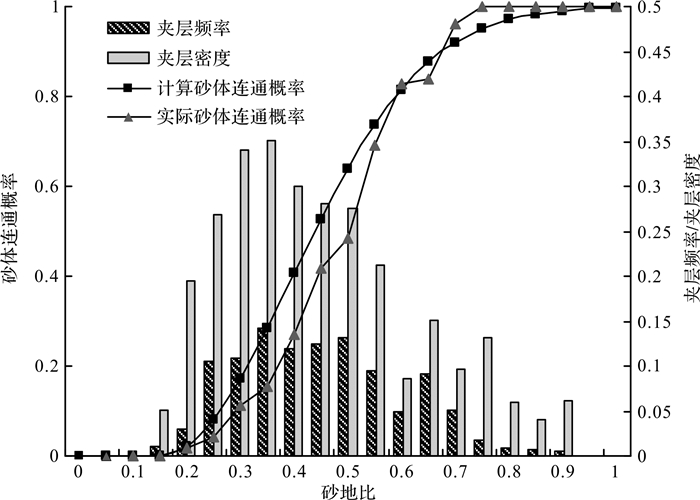
|
| 图 5 砂地比与砂体连通概率关系 Figure 5 Relationship between sand content and connectivity probability of the sand body |
笔者认为,对于鄂尔多斯盆地延长组而言,其地质构造简单,各小层厚度变化不大,影响砂地比值大小的根本原因在于各小层河道砂体的发育程度。但若有夹层发育则会使得垂向上砂体发育的连续性中断,特别是横向连续的夹层,使得砂体叠置样式多为孤立式,连通性变差。在分析砂地比与砂体连通性的关系时,存在砂地比一致而夹层发育状况不同,使得其砂体连通概率也不同的现象。因此笔者认为在运用该公式计算砂体连通概率时,还应考虑到夹层发育状况的影响。通过曲线拟合分析各个夹层参数(包括夹层厚度、夹层频率、夹层密度)对砂体连通性的影响,结果表明考虑夹层频率分析砂体连通概率的效果最好,为此将上式加以改进,提出新的砂体连通概率公式:
 (4)
(4)
式中,P为砂体连通概率;F=Sn×(1-Pk)2,可称之为连通系数;Sn为砂地比;Pk为夹层频率;b=(C-C0)/ 
根据所做的砂体连通剖面图判断井间砂体连通性,并统计分析砂体连通概率与连通系数关系(图 6),可看出计算结果与统计结果基本一致,误差很小,故该公式可用于分析计算研究区长8段砂体连通概率。图 6表示当连通系数小于0.14时,井间砂体不连通;当连通系数大于0.64时,井间砂体完全连通;当连通系数处于0.14与0.64之间时,砂体连通概率则随连通系数增大而升高。
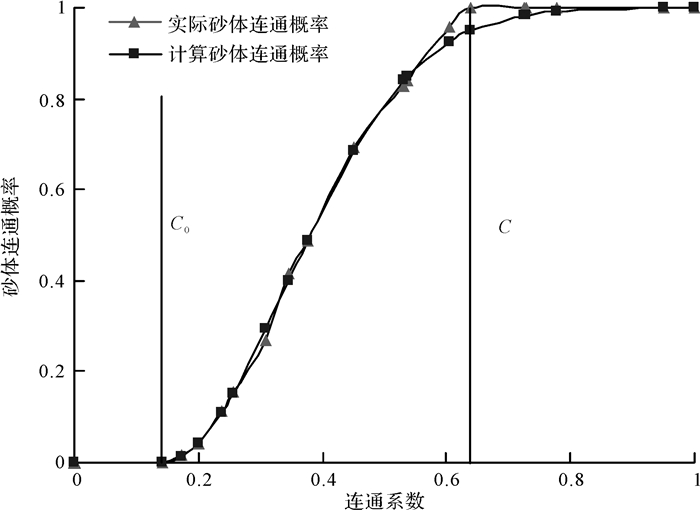
|
| 图 6 砂体连通概率判别模型 Figure 6 Evaluation model of connectivity probability for the sand body |
本次利用新建的砂体连通概率公式(式(4))计算研究区长8段储层砂体连通概率,并作出砂体连通概率平面分布图(图 7),可看出研究区北部①~⑥油藏与南部⑦~⑩油藏间的砂体连通概率较低,为此可将研究区整体分为南北两个“砂体连通体”。南北两个“砂体连通体”内各小油藏间砂体呈网状相互连接,根据各小油藏间砂体连通概率,可初步判断研究区北部②、④、⑤、⑥小油藏之间,南部⑦、⑩油藏之间的储层砂体连通性较好,其余各油藏间砂体连通概率不等,但有仍有砂体连接各个油藏,但各油藏间流体是否连通还需进一步分析。

|
| 图 7 鄂尔多斯盆地马岭地区长8段砂体连通概率分布图 Figure 7 Distribution of sand body connectivity probability for the Chang 8 member reservoir in the Maling area of the Ordos Basin |
上述方法是运用静态资料分析储层砂体连通性,油藏间储层砂体在空间上几何连通并不一定表示储层砂体内部的流体连通,只有储层砂体内部的流体连通,才表明油藏之间是连通的,油藏连通性也故名为“油藏间动态连通性”。与中高渗构造油藏不同,特低渗岩性油藏具有储层物性差、非均质性强的特点,没有统一的油水界面、压力系统。因此,利用地层水及原油性质、地层压力的差异判断油藏间动态连通性不适用于马岭地区长8油藏,而利用原油色谱分析则是解决这个问题的有效的方法。
鄂尔多斯盆地中生界原油主要来源于延长组长7层优质烃源岩,是生烃母质处于成熟—高成熟阶段的产物[56],原油的烷烃分布特征基本相同,但由于油气运移距离、油气成藏特征及其储集层特征的差异,使得不同产层、不同油藏的原油色谱特征存在着明显差别。因此可以应用原油全烃色谱的对比判断油藏的连通性。利用原油全烃色谱特征来研究油藏连通性时,由于样品在采集、储存和实验室内处理过程中,轻烃往往易于挥发[57],因此色谱特征参数和轻重比参数采用nC8之后的全烃色谱进行对比分析。
通过求取各个油藏原油色谱特征峰对比值的均值并加以对比,来判断油藏动态连通性。分析中采用作极坐标绘制星状图的方式进行对比,若油藏间相互连通则星状图形状相似,否则形状差异较大。
由研究区各个小油藏原油轻、重烷烃色谱对比星状图(图 8,9)可看出研究区③油藏与其余油藏差异最大,而其余油藏则明显分为两组,一组为①、②、④、⑤、⑥油藏,另一组为⑦、⑧、⑨、⑩油藏。
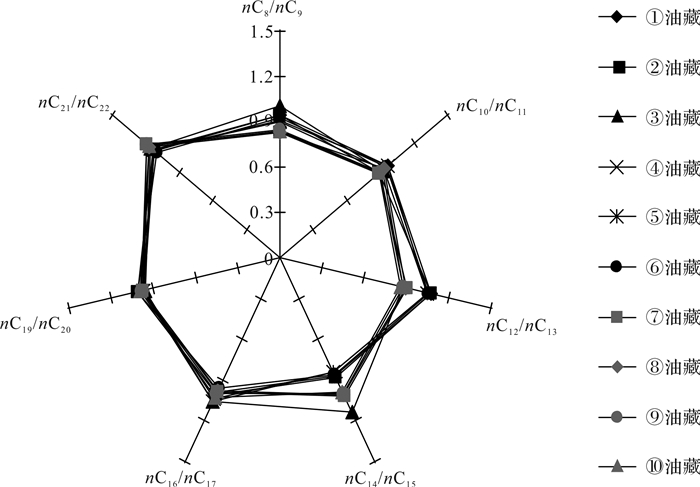
|
| 图 8 各油藏原油轻烃色谱对比星状图 Figure 8 Contrast star chart of crude petroleum light hydrocarbon chromatography in various reservoirs |

|
| 图 9 各油藏原油重烃色谱对比星状图 Figure 9 Contrast star chart of crude petroleum heavy hydrocarbon chromatography in various reservoirs |
通过原油轻、重烷烃色谱对比分析,并结合前文对储层静态砂体连通性的研究(图 7),分析认为,因砂体连通性差而导致南北两个“砂体连通体”之间流体连通性差;③油藏与周围②、⑤、⑥油藏之间均有砂体连通,但砂体内部的流体却不连通,这是因为砂体物性(孔、渗性)是影响流体运移能力、运移效率和运移距离的根本因素,而特低渗岩性油藏非均质性强,则易造成静态砂体连通但因连通砂体的物性较差而使得流体无法连通的现象。
综合分析认为,研究区长8段各油藏共可划分为三个流体连通系统,每一个系统内油藏之间相互连通,不同系统内的油藏间连通性差,即研究区①、②、④、⑤、⑥油藏之间动态连通性较好,⑦、⑧、⑨、⑩油藏之间动态连通性较好,而③油藏与其余各个油藏之间的动态连通性较差。
4 油藏间连通性分析的动态验证根据岩性油藏油气运移、聚集原理,若两个岩性油藏间相互连通,则油藏间物性较好的砂体部位(同时具备岩性遮挡)就会有油气聚集,为此可通过寻找连通油藏间的砂体发育带来发现新的油气富集区。如图 1中的④油藏,④油藏是马岭地区目前最大的油藏,其实它也是由若干个小油藏组成的,各个小油藏间相互连通从而形成一个大油藏。针对研究区长8段各个小油藏分布特点,可通过在各个油藏间能否发现新的油气富集区来判断以上油藏连通性的分析方法是否合理有效。
在确定油藏连通性的基础上,连通油藏间的连通概率高的砂体发育带可作为未来勘探评价的目标区。为此圈定研究区各小油藏间的砂体发育带,并叠合马岭地区最新油藏评价部署图(图 10),对比可看出,各小油藏间的砂体发育带基本均位于有利区范围内,研究区大体分为北部与南部两个有利区,分别在北部①、②、④、⑤、⑥油藏及南部⑦、⑧、⑨、⑩油藏周围大面积连片分布,而③油藏与这些有利区不连接。以上说明,前文对各个油藏间的连通性分析是正确的,这套油藏连通性分析方法是合理可行的。

|
| 图 10 鄂尔多斯盆地马岭地区长8段最新评价部署图 Figure 10 Distribution of the latest evaluation deployment for the Chang 8 member in the Maling area of the Ordos Basin |
(1) 研究区长8段砂体叠置样式分为孤立式、接触式、切叠式三种,其中切叠式砂体间连通性较好。建立了基于夹层发育状况下的砂体连通概率公式,并计算了研究区长8段储层砂体连通概率。
(2) 通过原油色谱分析并结合砂体连通概率分布,可将研究区长8段油藏划分为三个流体连通系统,每一个系统内油藏之间相互连通,不同系统内的油藏间连通性差。
(3) 判断各特低渗岩性油藏之间的连通性,首先从分析储层砂体的连通性,再运用动态资料判断油藏间流体的连通性。这套方法主要用于分析勘探前期阶段油藏间连通性,以寻找新的油气富集区,为下一步油气勘探部署提供依据。
| [1] |
张云峰, 刘宗堡, 赵容生, 等. 三角洲平原亚相储层砂体静态连通性定量表征:以松辽盆地肇州油田扶余油层为例[J]. 中国矿业大学学报, 2017, 46(6): 1314-1321. [ Zhang Yunfeng, Liu Zongbao, Zhao Rongsheng, et al. Quantitative characterization of delta plainsubfacies reservoir sandbody static connectivity:Taking Fuyu oil layer of Zhaozhou oil Field in Songliao Basin as an example[J]. Journal of China University of Mining & Technology, 2017, 46(6): 1314-1321.] |
| [2] |
张磊夫, 王红亮, 李英烈, 等. 砂体融合的定量表征及其对储集层连通性的控制[J]. 石油勘探与开发, 2017, 44(2): 205-212. [ Zhang Leifu, Wang Hongliang, Li Yinglie, et al. Quantitative characterization of sandstone amalgamation and its impact on reservoir connectivity[J]. Petroleum Exploration and Development, 2017, 44(2): 205-212.] |
| [3] |
Gazi N H, Ali F, Al-Naqi M, et al. Reservoir connectivity analysis using long term interference testing in a waterflood pilot in the carbonate Marrat formation of the Greater Burgan field, Kuwait[C]//Proceedings of SPE annual technical conference and exhibition. San Antonio, Texas, USA: SPE, 2012: 1-12.
|
| [4] |
孙涛, 窦宏恩, 邹存友, 等. 井间动态连通性评价新方法研究[J]. 特种油气藏, 2017, 24(2): 110-114. [ Sun Tao, Dou Hong'en, Zou Cunyou, et al. A new method for inter-well dynamic communication evaluation[J]. Special Oil & Gas Reservoirs, 2017, 24(2): 110-114. DOI:10.3969/j.issn.1006-6535.2017.02.022] |
| [5] |
罗晓容, 雷裕红, 张立宽, 等. 油气运移输导层研究及量化表征方法[J]. 石油学报, 2012, 33(3): 428-436. [ Luo Xiaorong, Lei Yuhong, Zhang Likuan, et al. Characterization of carrier formation for hydrocarbon migration:concepts and approaches[J]. Acta Petrolei Sinica, 2012, 33(3): 428-436.] |
| [6] |
田景春, 张兴良, 王峰, 等. 鄂尔多斯盆地高桥地区上古生界储集砂体叠置关系及分布定量刻画[J]. 石油与天然气地质, 2013, 34(6): 737-742, 815. [ Tian Jingchun, Zhang Xingliang, Wang Feng, et al. Quantitative characterization of superimposition relationship and distribution of reservoir sandbodies in the Upper Palaeozoic of Gaoqiao region, the Ordos Basin[J]. Oil & Gas Geology, 2013, 34(6): 737-742, 815.] |
| [7] |
封从军, 鲍志东, 单启铜, 等. 三角洲平原复合分流河道内部单砂体划分:以扶余油田中区南部泉头组四段为例[J]. 石油与天然气地质, 2012, 33(1): 77-83. [ Feng Congjun, Bao Zhidong, Shan Qitong, et al. Single sand body identification in compound distributary channel of delta plain:A case study from the fourth member of Quantou Formation in the southern part of central Fuyu oilfield[J]. Oil & Gas Geology, 2012, 33(1): 77-83.] |
| [8] |
赵春明, 胡景双, 霍春亮, 等. 曲流河与辫状河沉积砂体连通模式及开发特征:以渤海地区秦皇岛32-6油田为例[J]. 油气地质与采收率, 2009, 16(6): 88-91. [ Zhao Chunming, Hu Jingshuang, Huo Chunliang, et al. Sandbody interconneetivity architecture and development characteristics of meandering river and braided river deposits:A case study of Qinhuangdao 32-6 oilfield, Bohai area[J]. Petroleum Geology and Recovery Efficiency, 2009, 16(6): 88-91. DOI:10.3969/j.issn.1009-9603.2009.06.024] |
| [9] |
Leeder M R. Fluvial fining-up wards cycles and the magnitude of paleochannels[J]. Geology Magazine, 1973, 110(3): 265-276. DOI:10.1017/S0016756800036098 |
| [10] |
Bridge J S, Mackey S D. A theoretical study of fluvial sandstone body dimensions[J]. Special Publications of the International Association of Sedimentologists, 1993, 15(1): 65-82. |
| [11] |
Bridge J S, Tye R S. Interpreting the dimensions of ancient fluvial channel bars, channels, and channel belts from wireline-logs and cores[J]. AAPG Bulletin, 2000, 84(8): 1205-1228. |
| [12] |
Allen J R L. Studies in fluviatile sedimentation:An exploratory quantitative model for the architecture of avulsion-controlled alluvial suites[J]. Sedimentary Geology, 1978, 21(2): 129-147. DOI:10.1016/0037-0738(78)90002-7 |
| [13] |
裘亦楠. 储层沉积学研究工作流程[J]. 石油勘探与开发, 1990, 17(1): 85-90. [ Qiu Yi'nan. A proposed flow-diagram for reservoir sedimentological study[J]. Petroleum Exploration and Development, 1990, 17(1): 85-90.] |
| [14] |
King P R. The connectivity and conductivity of overlapping sand bodies[M]//Buller A T, Berg E, Hjelmeland O, et al. North sea oil and gas reservoirs-Ⅱ. Dordrecht: Springer, 1990: 353-362.
|
| [15] |
雷裕红, 罗晓容, 张立宽, 等. 东营凹陷南斜坡东段沙河街组砂岩输导层连通性量化表征[J]. 石油学报, 2013, 34(4): 692-700. [ Lei Yuhong, Luo Xiaorong, Zhang Likuan, et al. Quantitative characterization of Shahejie Formation sandstone carrier connectivity of the eastern part of the south slope in Dongying Sag[J]. Acta Petrolei Sinica, 2013, 34(4): 692-700.] |
| [16] |
Lei Y H, Luo X R, Song G Q, et al. Quantitative characterization of connectivity and conductivity of sandstone carriers during secondary petroleum migration, applied to the Third Member of Eocene Shahejie Formation, Dongying Depression, Eastern China[J]. Marine and Petroleum Geology, 2014, 51: 268-285. DOI:10.1016/j.marpetgeo.2013.12.022 |
| [17] |
赵健, 罗晓容, 张宝收, 等. 塔中地区志留系柯坪塔格组砂岩输导层量化表征及有效性评价[J]. 石油学报, 2011, 32(6): 949-958. [ Zhao Jian, Luo Xiaorong, Zhang Baoshou, et al. A quantitative characterization and effectiveness evaluation on sandstone carrier beds of the Silurian Kalpintag Formation in the Tazhong area, Tarim Basin[J]. Acta Petrolei Sinica, 2011, 32(6): 949-958.] |
| [18] |
刘振宇, 曾昭英, 翟云芳, 等. 利用脉冲试井方法研究低渗透油藏的连通性[J]. 石油学报, 2003, 24(1): 73-77. [ Liu Zhenyu, Zeng Zhaoying, Zhai Yunfang, et al. Study on connectivity of low-permeability reservoirs with pulse-testing method[J]. Acta Petrolei Sinica, 2003, 24(1): 73-77. DOI:10.3321/j.issn:0253-2697.2003.01.014] |
| [19] |
廖红伟, 王琛, 左代荣. 应用不稳定试井判断井间连通性[J]. 石油勘探与开发, 2002, 29(4): 87-89. [ Liao Hongwei, Wang Chen, Zuo Dairong. Applying transient testing to the judgement of inter-well connectivity[J]. Petroleum Exploration and Development, 2002, 29(4): 87-89. DOI:10.3321/j.issn:1000-0747.2002.04.027] |
| [20] |
Pomerantz A E, Ventura G T, McKenna A M, et al. Combining biomarker and bulk compositional gradient analysis to assess reservoir connectivity[J]. Organic Geochemistry, 2010, 41(8): 812-821. DOI:10.1016/j.orggeochem.2010.05.003 |
| [21] |
张钊, 陈明强, 高永利. 应用示踪技术评价低渗透油藏油水井间连通关系[J]. 西安石油大学学报(自然科学版), 2006, 21(3): 48-51. [ Zhang Zhao, Chen Mingqiang, Gao Yongli. Estimation of the connectivity between oil wells and water injection wells in low-permeability reservoir using tracer detection technique[J]. Journal of Xi'an Shiyou University (Natural Science Edition), 2006, 21(3): 48-51. DOI:10.3969/j.issn.1673-064X.2006.03.013] |
| [22] |
陈坤, 何文祥, 魏君. 井间示踪剂在油藏连通性分析中的应用:以马厂油田为例[J]. 长江大学学报(自然版), 2015, 12(8): 70-73, 77. [ Chen Kun, He Wenxiang, Wei Jun. Application of interwell tracer method in analysis of reservoir connectivity[J]. Journal of Yangtze University (Natural Science Edition), 2015, 12(8): 70-73, 77.] |
| [23] |
赵辉, 姚军, 吕爱民, 等. 利用注采开发数据反演油藏井间动态连通性[J]. 中国石油大学学报(自然科学版), 2010, 34(6): 91-94, 98. [ Zhao Hui, Yao Jun, Lü Aimin, et al. Reservoir interwell dynamic connectivity inversion based on injection and production data[J]. Journal of China University of Petroleum, 2010, 34(6): 91-94, 98. DOI:10.3969/j.issn.1673-5005.2010.06.017] |
| [24] |
赵辉, 康志江, 孙海涛, 等. 水驱开发多层油藏井间连通性反演模型[J]. 石油勘探与开发, 2016, 43(1): 99-106. [ Zhao Hui, Kang Zhijiang, Sun Haitao, et al. An interwell connectivity inversion model for waterflooded multilayer reservoirs[J]. Petroleum Exploration and Development, 2016, 43(1): 99-106.] |
| [25] |
Hird K B, Dubrule O. Quantification of reservoir connectivity for reservoir description applications[J]. SPE Reservoir Evaluation & Engineering, 1998, 1(1): 12-17. |
| [26] |
Heffer K J, Fox R J, McGill C A, et al. Novel techniques show links between reservoir flow directionality, earth stress, fault structure and geomechanical changes in mature waterfloods[J]. SPE Journal, 1997, 2(2): 91-98. DOI:10.2118/30711-PA |
| [27] |
Alejandro A, Lake L W. Inferring interwell connectivity from well-rate fluctuations in waterfloods[C]//Proceedings of SPE/DOE improved oil recovery symposium. Tulsa, Oklahoma: SPE, 2002: 6-16.
|
| [28] |
Panda M N, Chopra A K. An integrated approach to estimate well interactions[C]//Proceedings of SPE India oil and gas conference and exhibition. New Delhi, India: SPE, 1998: 53-66.
|
| [29] |
Yousef A A, Jensen J, Lake L W. Integrated interpretation of interwell connectivity using injection and production fluctuations[J]. Mathematical Geosciences, 2009, 41(1): 81-102. |
| [30] |
张明安. 油藏井间动态连通性反演方法研究[J]. 油气地质与采收率, 2011, 18(3): 70-73. [ Zhang Ming'an. Study on inversion for reservoir inter-well dynamic connectivity[J]. Petroleum Geology and Recovery Efficiency, 2011, 18(3): 70-73. DOI:10.3969/j.issn.1009-9603.2011.03.019] |
| [31] |
赵辉, 康志江, 张允, 等. 表征井间地层参数及油水动态的连通性计算方法[J]. 石油学报, 2014, 35(5): 922-927. [ Zhao Hui, Kang Zhijiang, Zhang Yun, et al. An interwell connectivity numerical method for geological parameter characterization and oil-water two-phase dynamic prediction[J]. Acta Petrolei Sinica, 2014, 35(5): 922-927.] |
| [32] |
Jamali A, Ettehadtavakkol A. Application of capacitance resistance models to determining interwell connectivity of large-scale mature oil fields[J]. Petroleum Exploration and Development, 2017, 41(1): 132-138. |
| [33] |
Kaviani D, Soroush M, Jensen J L. How accurate are Capacitance Model connectivity estimates?[J]. Journal of Petroleum Science and Engineering, 2014, 122: 439-452. DOI:10.1016/j.petrol.2014.08.003 |
| [34] |
Wang D G, Li Y, Chen B L, et al. Ensemble-based optimization of interwell connectivity in heterogeneous waterflooding reservoirs[J]. Journal of Natural Gas Science and Engineering, 2017, 38: 245-256. DOI:10.1016/j.jngse.2016.12.030 |
| [35] |
Liang X M. A simple model to infer interwell connectivity only from well-rate fluctuations in waterfloods[J]. Journal of Petroleum Science and Engineering, 2010, 70(1/2): 35-43. |
| [36] |
Yousef A A, Gentil P H, Jensen J L, et al. A capacitance model to infer interwell connectivity from production and injection rate fluctuations[J]. SPE Reservoir Evaluation & Engineering, 2006, 9(6): 630-646. |
| [37] |
Lake L W, Liang X M, Edgar T F, et al. Optimization of oil production based on a capacitance model of production and injection rates[C]//Proceedings of hydrocarbon economics and evaluation symposium. Dallas, Texas, USA: SPE, 2007: 504-513.
|
| [38] |
Weber D, Edgar T F, Lake L W, et al. Improvements in capacitance-resistive modeling and optimization of large scale reservoirs[C]//Proceedings of SPE western regional meeting. San Jose, California: SPE, 2009: 1-17.
|
| [39] |
Lee K H, Ortega A, Jafroodi N, et al. A multivariate autoregressive model for characterizing producer-producer relationships in waterfloods from injection/production rate fluctuations[C]//Proceedings of SPE western regional meeting. Anaheim, California, USA: SPE, 2010: 1-16.
|
| [40] |
Nguyen A P, Lasdon L, Lake L W, et al. Capacitance resistive model application to optimize waterflood in a west texas field[C]//Proceedings of SPE annual technical conference and exhibition. Denver, Colorado, USA: SPE, 2011: 1-13.
|
| [41] |
Soroush M, Jensen J, Kaviani D. Interwell connectivity evaluation in cases of frequent production interruptions[C]//Proceedings of SPE heavy oil conference-Canada. Calgary, Alberta, Canada: SPE, 2013: 1-21.
|
| [42] |
邓英尔, 刘树根, 麻翠杰. 井间连通性的综合分析方法[J]. 断块油气田, 2003, 10(5): 50-53. [ Deng Ying'er, Liu Shugen, Ma Cuijie. Aggregate analysis method of continuity of formation between wells[J]. Fault-Block Oil & Gas Field, 2003, 10(5): 50-53. DOI:10.3969/j.issn.1005-8907.2003.05.015] |
| [43] |
蔡春芳. 油藏流体连通性水化学指纹分析[J]. 断块油气田, 1997, 4(2): 33-35. [ Cai Chunfang. Identification of reservoir fluid continuity by hydrochemitry fingerprinting[J]. Fault-Block Oil & Gas Field, 1997, 4(2): 33-35.] |
| [44] |
马亭, 梅博文, 张俊, 等. 轮南油田三叠系油藏连通性的地球化学研究[J]. 石油学报, 1997, 18(4): 38-42. [ Ma Ting, Mei Bowen, Zhang Jun, et al. A study on reservoir continuity of Triassic reservoirs of Lunna oilfield in Tarim Basin[J]. Acta Petrolei Sinica, 1997, 18(4): 38-42. DOI:10.3321/j.issn:0253-2697.1997.04.007] |
| [45] |
文志刚, 朱丹, 李玉泉, 等. 应用色谱指纹技术研究孤东油田六区块油层连通性[J]. 石油勘探与开发, 2004, 31(1): 82-83. [ Wen Zhigang, Zhu Dan, Li Yuquan, et al. Oil layer connectivity in the sixth block of Gudong oilfield, the evidence from gas chromatography fingerprint technique[J]. Petroleum Exploration and Development, 2004, 31(1): 82-83. DOI:10.3321/j.issn:1000-0747.2004.01.025] |
| [46] |
Xu Y H, Shen X D, Chen N X, et al. Evaluation of reservoir connectivity using whole-oil gas chromatographic fingerprint technology:a case study from the Es33 reservoir in the Nanpu Sag, China[J]. Petroleum Science, 2012, 9(3): 290-294. DOI:10.1007/s12182-012-0211-z |
| [47] |
Sun P Y, Bao M T, Li G M, et al. Fingerprinting and source identification of an oil spill in China Bohai Sea by gas chromatography-flame ionization detection and gas chromatography-mass spectrometry coupled with multi-statistical analyses[J]. Journal of Chromatography A, 2009, 1216(5): 830-836. DOI:10.1016/j.chroma.2008.11.100 |
| [48] |
罗丽容, 李剑锋, 吴凯, 等. 原油色谱指纹技术在长庆油田五里湾一区分层产能监测中的应用[J]. 延安大学学报(自然科学版), 2013, 32(1): 62-66. [ Luo Lirong, Li Jianfeng, Wu Kai, et al. Application of oil chromatographic fingerprint technique in monitoring individual zone production allocation of commingled oil wells in No.1 Wuliwan area of Changqing oilfield[J]. Journal of Yanan University (Natural Science Edition), 2013, 32(1): 62-66. DOI:10.3969/J.ISSN.1004-602X.2013.01.062] |
| [49] |
罗丽容, 李剑锋, 吴凯, 等. 原油气相色谱指纹技术在油层连通性研究中的应用[J]. 石油化工应用, 2013, 32(8): 5-10. [ Luo Lirong, Li Jianfeng, Wu Kai, et al. Application of oil chromatographic fingerprint technique in studying oil layer connectivity[J]. Petrochemical Industry Application, 2013, 32(8): 5-10. DOI:10.3969/j.issn.1673-5285.2013.08.002] |
| [50] |
何文祥, 吴胜和, 龚厚琼, 等. 一种定量判别油藏流体连通性的新方法[J]. 石油学报, 2004, 25(6): 78-82. [ He Wenxiang, Wu Shenghe, Gong Houqiong, et al. A new method for quantitative identification of fluid continuity in reservoir[J]. Acta Petrolei Sinica, 2004, 25(6): 78-82. DOI:10.3321/j.issn:0253-2697.2004.06.016] |
| [51] |
吴保祥, 段毅, 郑朝阳, 等. 鄂尔多斯盆地中生界油藏连通性特征研究:以定边-安边以南地区为例[J]. 地球学报, 2008, 29(5): 628-632. [ Wu Baoxiang, Duan Yi, Zheng Chaoyang, et al. A study of mesozoic oil reservoir connectivity in the Ordos Basin:A case study of the southern Anbian-Dingbian area[J]. Acta Geoscientica Sinica, 2008, 29(5): 628-632. DOI:10.3321/j.issn:1006-3021.2008.05.013] |
| [52] |
孟祥宏, 王多云, 李树同, 等. 马岭-镇北地区延长组长8油组的砂体类型与多层叠置的连续型油藏特征[J]. 沉积学报, 2011, 29(6): 1206-1212. [ Meng Xianghong, Wang Duoyun, Li Shutong, et al. Characteristics and reservoir forming mode of the oil pools of Chang 8 reservoir in Maling-Zhenbei area, Ordos Basin[J]. Acta Sedimentologica Sinica, 2011, 29(6): 1206-1212.] |
| [53] |
王振奇, 何贞铭, 张昌民, 等. 三角洲前缘露头储层层次分析:以鄂尔多斯盆地东缘潭家河剖面为例[J]. 江汉石油学院学报, 2004, 26(4): 32-35. [ Wang Zhenqi, He Zhenming, Zhang Changmin, et al. Analysis on reservoir hierarchy of deltaic front outcrops-taking Tanjiahe outcrop in eastern Ordos Basin for example[J]. Journal of Jianghan Petroleum Institute, 2004, 26(4): 32-35. DOI:10.3969/j.issn.1000-9752.2004.04.010] |
| [54] |
赵小庆, 鲍志东, 刘宗飞, 等. 河控三角洲水下分流河道砂体储集层构型精细分析:以扶余油田探51区块为例[J]. 石油勘探与开发, 2013, 40(2): 181-187. [ Zhao Xiaoqing, Bao Zhidong, Liu Zongfei, et al. An in-depth analysis of reservoir architecture of underwater distributary channel sand bodies in a river dominated delta:A case study of T51 block, Fuyu oilfield[J]. Petroleum Exploration and Development, 2013, 40(2): 181-187.] |
| [55] |
兰朝利, 何顺利, 门成全. 利用岩心或露头的交错层组厚度预测辫状河河道带宽度:以鄂尔多斯盆地苏里格气田为例[J]. 油气地质与采收率, 2005, 12(2): 16-18. [ Lan Chaoli, He Shunli, Men Chengquan. Prediction of braided channel belt width based on cross-stratum sets thickness measurements of cores or outcrops-taking Sulige gas field, Ordos Basin as an example[J]. Petroleum Geology and Recovery Efficiency, 2005, 12(2): 16-18. DOI:10.3969/j.issn.1009-9603.2005.02.005] |
| [56] |
张文正, 杨华, 李剑锋, 等. 论鄂尔多斯盆地长7段优质油源岩在低渗透油气成藏富集中的主导作用:强生排烃特征及机理分析[J]. 石油勘探与开发, 2006, 33(3): 289-293. [ Zhang Wenzheng, Yang Hua, Li Jianfeng, et al. Leading effect of high-class source rock of Chang 7 in Ordos Basin on enrichment of low permeability oil-gas accumulation-hydrocarbon generation and expulsion mechanism[J]. Petroleum Exploration and Development, 2006, 33(3): 289-293. DOI:10.3321/j.issn:1000-0747.2006.03.006] |
| [57] |
孙秀丽, 万永刚, 刘照伟, 等. 挥发作用对C5-C8轻烃指标的影响:模拟实验证据[J]. 石油学报, 2013, 34(6): 1060-1069. [ Sun Xiuli, Wan Yonggang, Liu Zhaowei, et al. Effects of natural evaporation on C5-C8 light hydrocarbon indicators:Evidence from experimental results in the laboratory[J]. Acta Petrolei Sinica, 2013, 34(6): 1060-1069.] |
 2019, Vol. 37
2019, Vol. 37


